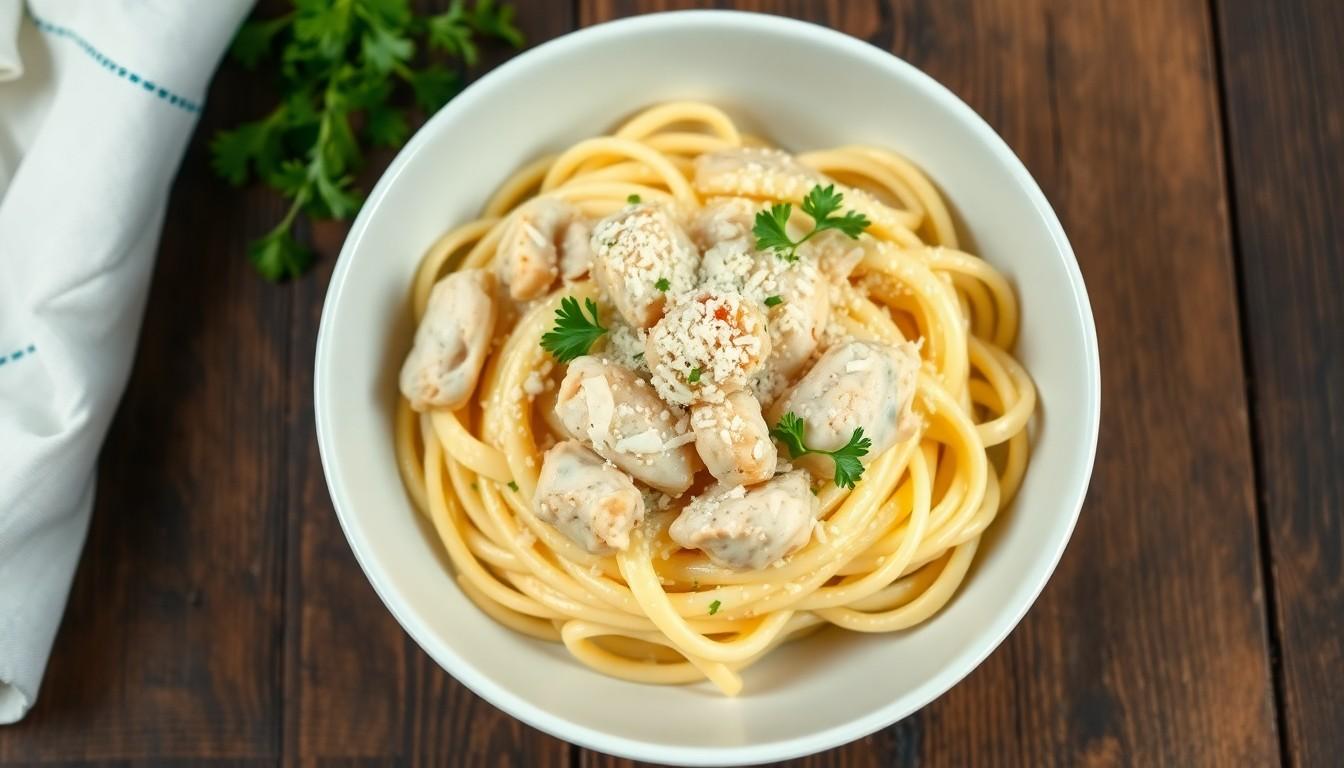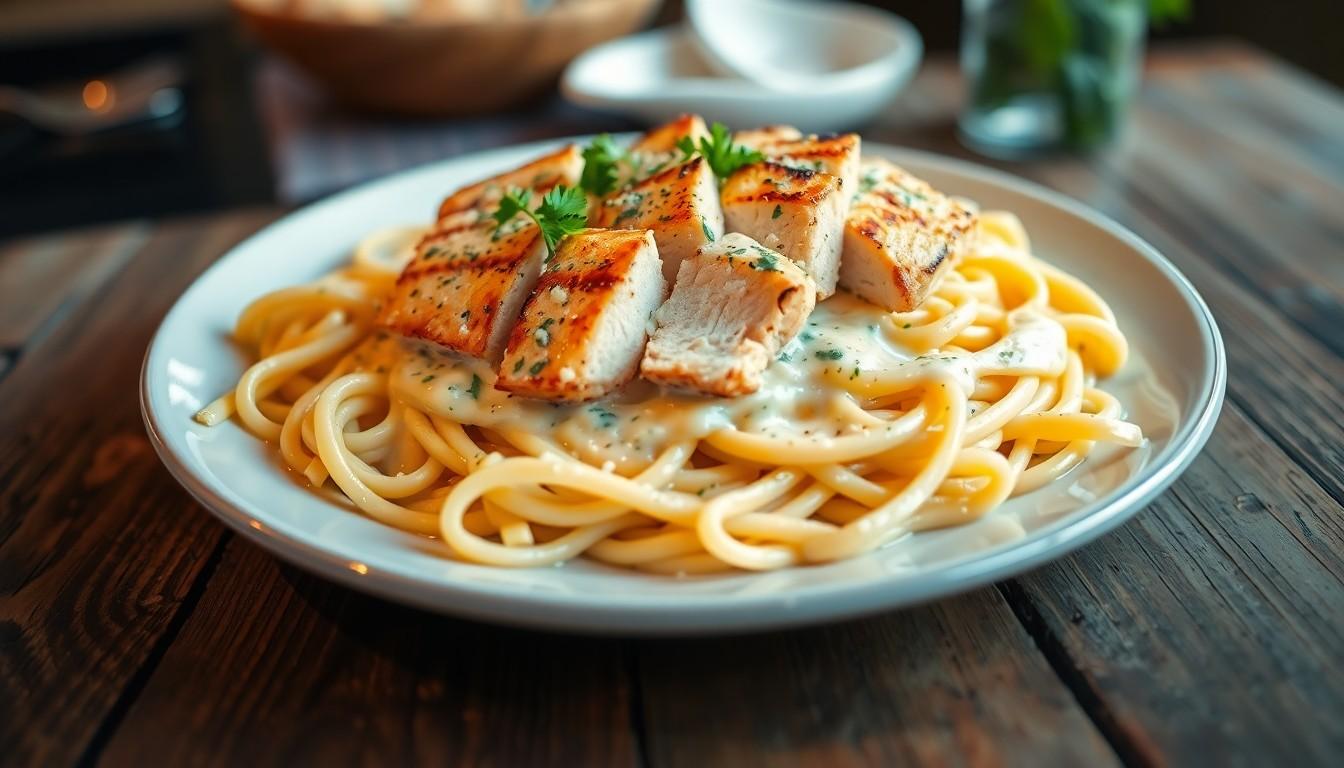Chicken Alfredo stands as one of America’s most beloved Italian-American dishes combining tender chicken breast fettuccine pasta and a rich creamy sauce. While this comfort food delivers incredible flavors it’s important to understand its nutritional impact on your diet.
The classic combination of heavy cream butter Parmesan cheese and pasta makes Chicken Alfredo a calorie-dense meal that’s high in both fats and carbohydrates. A typical restaurant serving can contain anywhere from 800 to 1200 calories making it a significant consideration for those watching their daily caloric intake or following specific dietary goals.
Chicken Alfredo Nutrition
Chicken Alfredo combines tender chicken breast with fettuccine pasta in a rich cream-based sauce. This Italian-American fusion dish gained popularity in restaurants across the United States during the 1970s.
Traditional Ingredients
Traditional Chicken Alfredo consists of five core ingredients:
-
- Fettuccine pasta made from durum wheat semolina flour
-
- Boneless skinless chicken breast cut into strips
-
- Heavy cream blended with unsalted butter
-
- Freshly grated Parmigiano-Reggiano cheese
-
- Fresh garlic minced into fine pieces
Modern Variations
-
- Protein alternatives: Shrimp grilled salmon blackened chicken
-
- Vegetable additions: Broccoli mushrooms sun-dried tomatoes
-
- Sauce modifications: Greek yogurt cream cheese mascarpone
-
- Pasta substitutes: Zucchini noodles cauliflower rice whole wheat fettuccine
-
- Seasoning enhancements: Italian herbs cracked black pepper red pepper flakes
| Component | Traditional | Modern Alternative |
|---|---|---|
| Base Pasta | Fettuccine | Zucchini Noodles |
| Protein | Chicken Breast | Shrimp or Salmon |
| Sauce Base | Heavy Cream | Greek Yogurt |
| Cheese | Parmigiano-Reggiano | Cream Cheese |
Nutritional Profile of Chicken Alfredo
A standard serving of chicken alfredo contains significant calories due to its cream-based sauce and pasta components. The dish’s nutritional composition varies based on portion size and specific ingredients used.
Calories and Macronutrients
A typical 2-cup serving (250g) of chicken alfredo provides these macronutrients:
| Nutrient | Amount per Serving |
|---|---|
| Calories | 1,200 |
| Protein | 48g |
| Total Fat | 75g |
| Saturated Fat | 47g |
| Carbohydrates | 98g |
| Fiber | 4g |
| Sugar | 4g |
The protein content comes primarily from:
-
- Grilled chicken breast (35g protein per serving)
-
- Parmesan cheese (8g protein per serving)
-
- Fettuccine pasta (5g protein per serving)
Vitamins and Minerals
The dish provides essential micronutrients from its core ingredients:
| Nutrient | % Daily Value |
|---|---|
| Calcium | 45% |
| Iron | 15% |
| Vitamin B12 | 25% |
| Vitamin D | 15% |
| Selenium | 65% |
| Phosphorus | 40% |
-
- Calcium from Parmesan cheese
-
- Iron from enriched pasta
-
- Selenium from chicken breast
-
- Phosphorus from dairy components
-
- Vitamin B12 from cream sauce
Health Benefits
Chicken Alfredo offers several nutritional advantages when incorporated into a balanced diet. The dish combines multiple ingredients that provide essential nutrients for various bodily functions.
Protein Content
A single serving of Chicken Alfredo delivers 48g of high-quality protein from three primary sources:
-
- Grilled chicken breast provides 30g of complete protein containing all essential amino acids
-
- Parmesan cheese adds 10g of protein plus branched-chain amino acids
-
- Fettuccine pasta contributes 8g of plant-based protein
This protein content supports:
-
- Muscle tissue repair after physical activity
-
- Immune system function through antibody production
-
- Enzyme creation for metabolic processes
Calcium and Bone Health
The dairy components in Chicken Alfredo create a calcium-rich meal that promotes skeletal strength:
| Ingredient | Calcium Content (per serving) |
|---|---|
| Parmesan | 336mg |
| Heavy Cream | 84mg |
| Total | 420mg |
The calcium benefits include:
-
- Enhanced bone mineral density
-
- Improved muscle contraction function
-
- Strengthened nerve signal transmission
-
- Regulated blood pressure maintenance
-
- Phosphorus from cheese (250mg)
-
- Magnesium from pasta (42mg)
-
- Vitamin D from cream (40 IU)
Potential Drawbacks
Chicken Alfredo presents several nutritional challenges that impact its role in a balanced diet. Understanding these limitations helps in making informed dietary choices.
High Calorie Content
A standard 2-cup serving of Chicken Alfredo contains 1,200 calories, representing 60% of a 2,000-calorie daily intake. The caloric density stems from three main sources:
-
- Heavy cream adds 415 calories per half cup
-
- Parmesan cheese contributes 216 calories per half cup
-
- Fettuccine pasta provides 200 calories per cup
Saturated Fat Concerns
The saturated fat content in Chicken Alfredo reaches 31g per serving, exceeding the American Heart Association’s recommended daily limit of 13g. Key contributors include:
| Ingredient | Saturated Fat (g) |
|---|---|
| Heavy Cream (1/2 cup) | 22 |
| Parmesan Cheese (1/2 cup) | 7 |
| Butter (2 tbsp) | 2 |
-
- Increased LDL cholesterol levels
-
- Enhanced risk of cardiovascular disease
-
- Potential weight management challenges
Tips for Making Healthier Chicken Alfredo
Creating a healthier version of chicken alfredo focuses on reducing calories while maintaining the dish’s creamy texture and rich flavors. These modifications minimize saturated fat content and enhance nutritional value through strategic ingredient choices and serving sizes.
Ingredient Substitutions
-
- Replace heavy cream with low-fat milk thickened with pureed cauliflower or Greek yogurt
-
- Substitute whole wheat or chickpea fettuccine for traditional pasta to increase fiber content
-
- Use lean chicken breast grilled without oil or butter
-
- Mix reduced-fat cream cheese with chicken broth for a lighter sauce base
-
- Add pureed white beans to create creaminess while boosting protein content
-
- Include nutritional yeast instead of full portions of Parmesan cheese
Portion Control
-
- Measure pasta portions to 1 cup (85g) cooked per serving
-
- Fill half the plate with steamed vegetables like broccoli or spinach
-
- Limit sauce to 1/4 cup (60ml) per serving
-
- Scale chicken portions to 4 ounces (113g) per person
-
- Use smaller dinner plates (8-9 inches) to manage serving sizes
-
- Pack leftovers immediately to avoid overeating
| Component | Standard Portion | Modified Portion | Calorie Reduction |
|---|---|---|---|
| Pasta | 2 cups (170g) | 1 cup (85g) | 200 calories |
| Sauce | 1/2 cup (120ml) | 1/4 cup (60ml) | 150 calories |
| Chicken | 6 oz (170g) | 4 oz (113g) | 100 calories |
| Total Reduction | – | – | 450 calories |
Countless modifications
Chicken Alfredo stands as a beloved Italian-American dish that offers both indulgence and nutritional benefits. While its rich creamy sauce and traditional ingredients contribute to a high caloric content they also provide essential nutrients like protein calcium and vitamin D.
For those seeking a healthier version countless modifications exist from ingredient substitutions to portion control strategies. These adaptations allow food enthusiasts to enjoy this classic comfort food while maintaining their dietary goals.
Whether enjoying the traditional recipe or opting for a lighter version understanding Chicken Alfredo’s nutritional profile helps make informed decisions about incorporating this popular dish into a balanced diet.
